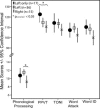Lateralization of the arcuate fasciculus from childhood to adulthood and its relation to cognitive abilities in children
- PMID: 19365801
- PMCID: PMC6870654
- DOI: 10.1002/hbm.20779
Lateralization of the arcuate fasciculus from childhood to adulthood and its relation to cognitive abilities in children
Abstract
The arcuate fasciculus is a major white matter tract involved in language processing that has also been repeatedly implicated in intelligence and reasoning tasks. Language in the human brain is lateralized in terms of both function and structure, and while the arcuate fasciculus reflects this asymmetry, its pattern of lateralization is poorly understood in children and adolescents. We used diffusion tensor imaging (DTI) and tractography to examine arcuate fasciculus lateralization in a large (n = 183) group of healthy right-handed volunteers aged 5-30 years; a subset of 68 children aged 5-13 years also underwent cognitive assessments. Fractional anisotropy and number of streamlines of the arcuate fasciculus were both significantly higher in the left hemisphere than the right hemisphere in most subjects, although some subjects (10%) were right lateralized. Age and gender effects on lateralization were not significant. Children receiving cognitive assessments were divided into three groups: a "left-only" group in whom only the left side of the arcuate fasciculus could be tracked, a left-lateralized group, and a right-lateralized group. Scores on the Peabody Picture Vocabulary Test (PPVT) and NEPSY Phonological Processing task differed significantly among groups, with left-only subjects outperforming the right-lateralized group on the PPVT, and the left-lateralized children scoring significantly better than the right-lateralized group on phonological processing. In summary, DTI tractography demonstrates leftward arcuate fasciculus lateralization in children, adolescents, and young adults, and reveals a relationship between structural white matter lateralization and specific cognitive abilities in children.
Figures




Similar articles
-
Arcuate fasciculus asymmetry has a hand in language function but not handedness.Hum Brain Mapp. 2016 Sep;37(9):3297-309. doi: 10.1002/hbm.23241. Epub 2016 May 4. Hum Brain Mapp. 2016. PMID: 27144738 Free PMC article.
-
Fiber density asymmetry of the arcuate fasciculus in relation to functional hemispheric language lateralization in both right- and left-handed healthy subjects: a combined fMRI and DTI study.Neuroimage. 2007 Apr 15;35(3):1064-76. doi: 10.1016/j.neuroimage.2006.12.041. Epub 2007 Jan 23. Neuroimage. 2007. PMID: 17320414
-
Tractography of the arcuate fasciculus in healthy right-handed and left-handed multilingual subjects and its relation to language lateralization on functional MRI.Sci Rep. 2021 Oct 22;11(1):20936. doi: 10.1038/s41598-021-00490-5. Sci Rep. 2021. PMID: 34686728 Free PMC article.
-
The lateralized cerebellum: insights into motor, cognitive, and affective functioning across ages: a scoping review.J Neurol. 2025 Jan 15;272(2):122. doi: 10.1007/s00415-024-12884-2. J Neurol. 2025. PMID: 39812809
-
Functional and structural brain asymmetries in language processing.Handb Clin Neurol. 2025;208:269-287. doi: 10.1016/B978-0-443-15646-5.00020-8. Handb Clin Neurol. 2025. PMID: 40074402 Review.
Cited by
-
Detection of the arcuate fasciculus in congenital amusia depends on the tractography algorithm.Front Psychol. 2015 Jan 21;6:9. doi: 10.3389/fpsyg.2015.00009. eCollection 2015. Front Psychol. 2015. PMID: 25653637 Free PMC article.
-
The time-locked neurodynamics of semantic processing in autism spectrum disorder: an EEG study.Cogn Neurodyn. 2022 Feb;16(1):43-72. doi: 10.1007/s11571-021-09697-8. Epub 2021 Jul 16. Cogn Neurodyn. 2022. PMID: 35126770 Free PMC article.
-
Structural and functional asymmetry of the language network emerge in early childhood.Dev Cogn Neurosci. 2019 Oct;39:100682. doi: 10.1016/j.dcn.2019.100682. Epub 2019 Jul 21. Dev Cogn Neurosci. 2019. PMID: 31376589 Free PMC article.
-
Rewiring the extremely preterm brain: Altered structural connectivity relates to language function.Neuroimage Clin. 2020;25:102194. doi: 10.1016/j.nicl.2020.102194. Epub 2020 Jan 22. Neuroimage Clin. 2020. PMID: 32032818 Free PMC article.
-
Decreased and Increased Anisotropy along Major Cerebral White Matter Tracts in Preterm Children and Adolescents.PLoS One. 2015 Nov 11;10(11):e0142860. doi: 10.1371/journal.pone.0142860. eCollection 2015. PLoS One. 2015. PMID: 26560745 Free PMC article.
References
-
- Ashtari M,Cervellione KL,Hasan KM,Wu J,McIlree C,Kester H,Ardekani BA,Roofeh D,Szeszko PR,Kumra S ( 2007): White matter development during late adolescence in healthy males: A cross‐sectional diffusion tensor imaging study. Neuroimage 35: 501–510. - PubMed
-
- Balsamo LM,Xu B,Grandin CB,Petrella JR,Braniecki SH,Elliott TK,Gaillard WD ( 2002): A functional magnetic resonance imaging study of left hemisphere language dominance in children. Arch Neurol 59: 1168–1174. - PubMed
-
- Barnea‐Goraly N,Menon V,Eckert M,Tamm L,Bammer R,Karchemskiy A,Dant CC,Reiss AL ( 2005): White matter development during childhood and adolescence: A cross‐sectional diffusion tensor imaging study. Cereb Cortex 15: 1848–1854. - PubMed
-
- Basser PJ,Pajevic S,Pierpaoli C,Duda J,Aldroubi A ( 2000): In vivo fiber tractography using DT‐MRI data. Magn Reson Med 44: 625–632. - PubMed
-
- Beaulieu C ( 2002): The basis of anisotropic water diffusion in the nervous system—A technical review. NMR Biomed 15: 435–455. - PubMed
Publication types
MeSH terms
LinkOut - more resources
Full Text Sources

